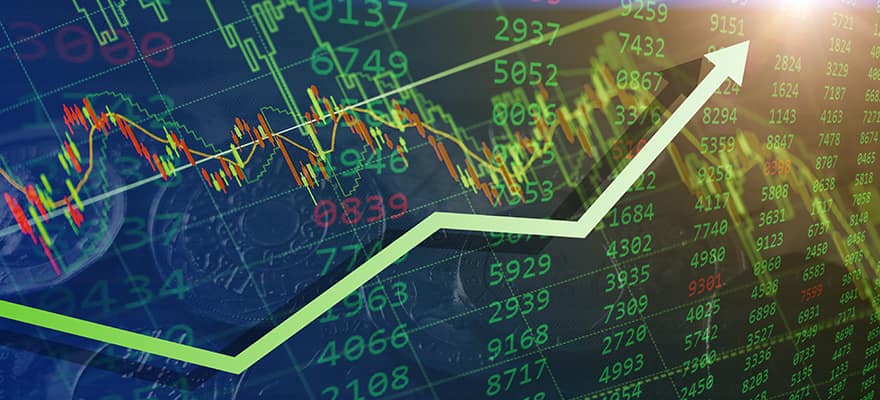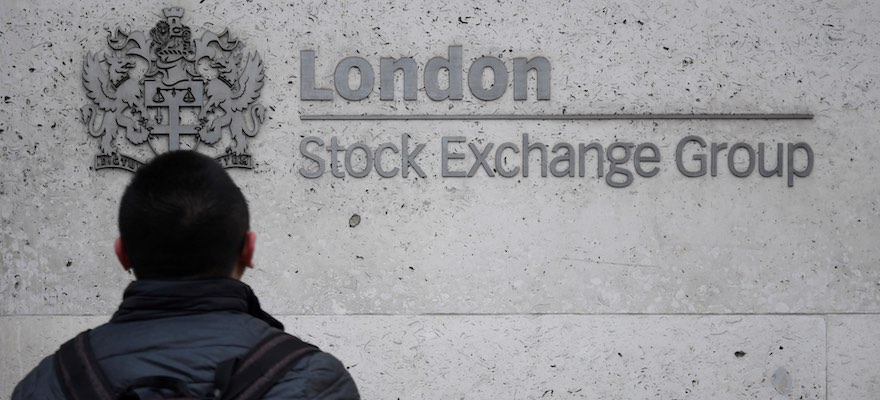Even in the mighty U.S. Treasury market, bond traders are taking their cues from central bankers in Europe and Japan.
With Mario Draghi and Haruhiko Kuroda pressing ahead with their grand monetary experiments, negative yields in Germany and Japan are exerting greater and greater influence over U.S. Treasuries. Overnight trading of Treasury futures has exploded, reaching levels not seen in years. Benchmark U.S. notes are also moving the most in tandem with German bunds since 2014.
The shift could have far-reaching consequences. As yields on trillions of dollars of euro-area and Japanese bonds sink further below zero, demand for Treasuries may mitigate any move by the Federal Reserve to push U.S. interest rates higher. What’s more, it may signal ultra-loose policies by the European Central Bank and Bank of Japan have the potential to undermine the Fed’s push to tighten, particularly if the dollar’s strength blunts inflation and growth.
“It used to be that everything was correlated to movements in U.S. Treasuries and now the U.S. seems to be following,” said Jim Caron, a money manager at Morgan Stanley Investment Management, which oversees $406 billion. Treasuries are “being more dominated by global events.”
Despite the backup in Treasury yields this month, they’re still lower than they were in December, when the Fed ended its near-zero rate policy and boosted borrowing costs for the first time in a decade. Yields of the benchmark 10-year were at 1.99 percent as of 12:56 p.m. in Tokyo on Monday, versus 2.27 percent at the end of 2015.
Demand for government bonds has pushed borrowing costs in almost every industrialized nation down this year, with average yields on $23 trillion of bonds falling to a record 0.69 percent in February, according to data compiled by Bloomberg. More than a quarter of those securities Yield
Yield
A yield is defined as the earnings generated by an investment or security over a particular time period. This is in typically displayed in percentage terms and is in the form of interest or dividends received from it.Yields do not include the price variations, which differentiates it from the total return. As such, a yield applies to various stated rates of return on stocks, fixed income instruments such as bonds, and other types of investment products.Yields can be calculated as a ratio or as a
A yield is defined as the earnings generated by an investment or security over a particular time period. This is in typically displayed in percentage terms and is in the form of interest or dividends received from it.Yields do not include the price variations, which differentiates it from the total return. As such, a yield applies to various stated rates of return on stocks, fixed income instruments such as bonds, and other types of investment products.Yields can be calculated as a ratio or as a
Read this Term less than zero.
A big part of it has to do with the unprecedented monetary easing that central bankers at the ECB and BOJ have undertaken to revive their moribund economies in the past year. In their latest announcements, the ECB surprised investors last week by cutting its deposit rate to minus 0.4 percent, increasing its bond buying and incorporating company bonds as part of its purchases. In February, the BOJ’s Kuroda added negative rates to its quantitative-easing program.
“Investors have to buy bonds,” said Hideaki Kuriki, a debt investor at Sumitomo Mitsui Trust Asset Management, which oversees $59 billion. “They can’t take risk.”
Those same forces are swaying the $13.3 trillion market for U.S. Treasuries. The proportion of futures trading in Treasuries that happens during Tokyo hours has jumped to about 8 percent, from about 4 percent mid-2015, data compiled by JPMorgan Chase & Co. show. A Goldman Sachs Group Inc. analysis of bond Volatility
Volatility
In finance, volatility refers to the amount of change in the rate of a financial instrument, such as commodities, currencies, stocks, over a given time period. Essentially, volatility describes the nature of an instrument’s fluctuation; a highly volatile security equates to large fluctuations in price, and a low volatile security equates to timid fluctuations in price. Volatility is an important statistical indicator used by financial traders to assist them in developing trading systems. Traders
In finance, volatility refers to the amount of change in the rate of a financial instrument, such as commodities, currencies, stocks, over a given time period. Essentially, volatility describes the nature of an instrument’s fluctuation; a highly volatile security equates to large fluctuations in price, and a low volatile security equates to timid fluctuations in price. Volatility is an important statistical indicator used by financial traders to assist them in developing trading systems. Traders
Read this Term showed that falling yields on Japanese government bonds have been defining the direction of the market.
Moves in Europe are also having a greater influence. Last month, the correlation of 10-year U.S. notes to moves in German bunds rose to 0.6625, based on a 120-day rolling average (a reading of one would mean they move in lockstep). That’s higher than at any time since December 2014.
The BOJ and ECB, “what they do will have a reasonable impact on Treasuries,” says Krishna Memani, who oversees $204 billion as chief investment officer at Oppenheimer Funds Inc. in New York.
With yields on benchmark 10-year Japanese bonds at minus 0.03 percent, comparable Treasuries have about a two-percentage point advantage. Last month alone, Japanese money managers plowed a net 3.56 trillion yen ($31.3 billion) into bonds abroad, the most since August 2010, according to the Ministry of Finance. More than 60 percent of the world’s negative-yielding debt is in Japan.
The downward pressure, along with concern a slowing global economy will weigh on U.S. growth, has forecasters chopping their estimates for how far 10-year Treasury yields will rise in 2016. They now expect yields to end the year at 2.35 percent from a projection of 2.82 percent in January.
The demand also shows that investors are skeptical the Fed can raise rates as much as some policy makers have indicated. Based on the median projection of Fed officials in December, they expect to raise the benchmark rate to 1.375 percent by year-end. Traders on the other hand, don’t see borrowing costs approaching 1 percent.
The Fed’s next policy meeting will be on March 15-16.
Policy divergence among central banks and ultra-low rates around the world are wreaking havoc in markets and making it harder for investors to know what to expect. Volatility in Treasuries have risen to all-time highs, while trade failures have increased in the overnight funding market as demand for 10-year notes has soared.
Despite the turbulence, some investors are convinced the Fed will stay the course and raise rates as improving U.S. economic data boosts the outlook for growth and inflation. A Citigroup Inc. index shows the strength of U.S. data relative to analyst forecasts has climbed to the highest since November.
“U.S. economic growth will continue, inflation will move up,” said David Kelly, chief global strategist of JPMorgan Funds. He anticipates the Fed will probably raise rates three times in 2016. “The U.S. will be a lot more healthy over the next year than either Japan or Europe.”
Some investors, such as Oppenheimer Funds’ Memani, are less sanguine. They say that extraordinary easing by the BOJ and ECB will weaken the yen and euro against the dollar and export deflation to the U.S. That in turn may undercut any inflationary pressures building up in the world’s largest economy and hamper growth -- just as Fed officials are looking to tighten.
While the dollar has slipped from its high in January, forecasters expect the greenback to appreciate against 14 of the world’s 16 major currencies this year, including the yen and euro. The dollar has surged almost 20 percent in the past two years against a basket of currencies tracked by Bloomberg. Inflation in the U.S. has averaged less than 1 percent in the same period.
Some policy makers have already taken note. Fed Governor Lael Brainard told CNBC television on March 7 that the U.S. economy was being buffeted by “powerful cross currents” from abroad and a further rise in the dollar would hit exports. Fed Vice Chairman Stanley Fischer also alluded to the dollar dilemma when he spoke in January.
“Because of what every other policy maker is doing, ECB or BOJ, you may have a situation where the dollar strengthens and slows down the U.S. economy meaningfully,” Memani said. Dollar strength may tighten “financial conditions in the U.S. far more than what the Fed wants to.”
To contact the reporters on this story: Susanne Walker Barton in New York at swalker33@bloomberg.net, Wes Goodman in Singapore at wgoodman@bloomberg.net, Alexandra Scaggs in New York at ascaggs@bloomberg.net. To contact the editors responsible for this story: Boris Korby at bkorby1@bloomberg.net, Garfield Reynolds at greynolds1@bloomberg.net, Michael Tsang
By: Susanne Walker Barton, Wes Goodman and Alexandra Scaggs
©2016 Bloomberg News
Even in the mighty U.S. Treasury market, bond traders are taking their cues from central bankers in Europe and Japan.
With Mario Draghi and Haruhiko Kuroda pressing ahead with their grand monetary experiments, negative yields in Germany and Japan are exerting greater and greater influence over U.S. Treasuries. Overnight trading of Treasury futures has exploded, reaching levels not seen in years. Benchmark U.S. notes are also moving the most in tandem with German bunds since 2014.
The shift could have far-reaching consequences. As yields on trillions of dollars of euro-area and Japanese bonds sink further below zero, demand for Treasuries may mitigate any move by the Federal Reserve to push U.S. interest rates higher. What’s more, it may signal ultra-loose policies by the European Central Bank and Bank of Japan have the potential to undermine the Fed’s push to tighten, particularly if the dollar’s strength blunts inflation and growth.
“It used to be that everything was correlated to movements in U.S. Treasuries and now the U.S. seems to be following,” said Jim Caron, a money manager at Morgan Stanley Investment Management, which oversees $406 billion. Treasuries are “being more dominated by global events.”
Despite the backup in Treasury yields this month, they’re still lower than they were in December, when the Fed ended its near-zero rate policy and boosted borrowing costs for the first time in a decade. Yields of the benchmark 10-year were at 1.99 percent as of 12:56 p.m. in Tokyo on Monday, versus 2.27 percent at the end of 2015.
Demand for government bonds has pushed borrowing costs in almost every industrialized nation down this year, with average yields on $23 trillion of bonds falling to a record 0.69 percent in February, according to data compiled by Bloomberg. More than a quarter of those securities Yield
Yield
A yield is defined as the earnings generated by an investment or security over a particular time period. This is in typically displayed in percentage terms and is in the form of interest or dividends received from it.Yields do not include the price variations, which differentiates it from the total return. As such, a yield applies to various stated rates of return on stocks, fixed income instruments such as bonds, and other types of investment products.Yields can be calculated as a ratio or as a
A yield is defined as the earnings generated by an investment or security over a particular time period. This is in typically displayed in percentage terms and is in the form of interest or dividends received from it.Yields do not include the price variations, which differentiates it from the total return. As such, a yield applies to various stated rates of return on stocks, fixed income instruments such as bonds, and other types of investment products.Yields can be calculated as a ratio or as a
Read this Term less than zero.
A big part of it has to do with the unprecedented monetary easing that central bankers at the ECB and BOJ have undertaken to revive their moribund economies in the past year. In their latest announcements, the ECB surprised investors last week by cutting its deposit rate to minus 0.4 percent, increasing its bond buying and incorporating company bonds as part of its purchases. In February, the BOJ’s Kuroda added negative rates to its quantitative-easing program.
“Investors have to buy bonds,” said Hideaki Kuriki, a debt investor at Sumitomo Mitsui Trust Asset Management, which oversees $59 billion. “They can’t take risk.”
Those same forces are swaying the $13.3 trillion market for U.S. Treasuries. The proportion of futures trading in Treasuries that happens during Tokyo hours has jumped to about 8 percent, from about 4 percent mid-2015, data compiled by JPMorgan Chase & Co. show. A Goldman Sachs Group Inc. analysis of bond Volatility
Volatility
In finance, volatility refers to the amount of change in the rate of a financial instrument, such as commodities, currencies, stocks, over a given time period. Essentially, volatility describes the nature of an instrument’s fluctuation; a highly volatile security equates to large fluctuations in price, and a low volatile security equates to timid fluctuations in price. Volatility is an important statistical indicator used by financial traders to assist them in developing trading systems. Traders
In finance, volatility refers to the amount of change in the rate of a financial instrument, such as commodities, currencies, stocks, over a given time period. Essentially, volatility describes the nature of an instrument’s fluctuation; a highly volatile security equates to large fluctuations in price, and a low volatile security equates to timid fluctuations in price. Volatility is an important statistical indicator used by financial traders to assist them in developing trading systems. Traders
Read this Term showed that falling yields on Japanese government bonds have been defining the direction of the market.
Moves in Europe are also having a greater influence. Last month, the correlation of 10-year U.S. notes to moves in German bunds rose to 0.6625, based on a 120-day rolling average (a reading of one would mean they move in lockstep). That’s higher than at any time since December 2014.
The BOJ and ECB, “what they do will have a reasonable impact on Treasuries,” says Krishna Memani, who oversees $204 billion as chief investment officer at Oppenheimer Funds Inc. in New York.
With yields on benchmark 10-year Japanese bonds at minus 0.03 percent, comparable Treasuries have about a two-percentage point advantage. Last month alone, Japanese money managers plowed a net 3.56 trillion yen ($31.3 billion) into bonds abroad, the most since August 2010, according to the Ministry of Finance. More than 60 percent of the world’s negative-yielding debt is in Japan.
The downward pressure, along with concern a slowing global economy will weigh on U.S. growth, has forecasters chopping their estimates for how far 10-year Treasury yields will rise in 2016. They now expect yields to end the year at 2.35 percent from a projection of 2.82 percent in January.
The demand also shows that investors are skeptical the Fed can raise rates as much as some policy makers have indicated. Based on the median projection of Fed officials in December, they expect to raise the benchmark rate to 1.375 percent by year-end. Traders on the other hand, don’t see borrowing costs approaching 1 percent.
The Fed’s next policy meeting will be on March 15-16.
Policy divergence among central banks and ultra-low rates around the world are wreaking havoc in markets and making it harder for investors to know what to expect. Volatility in Treasuries have risen to all-time highs, while trade failures have increased in the overnight funding market as demand for 10-year notes has soared.
Despite the turbulence, some investors are convinced the Fed will stay the course and raise rates as improving U.S. economic data boosts the outlook for growth and inflation. A Citigroup Inc. index shows the strength of U.S. data relative to analyst forecasts has climbed to the highest since November.
“U.S. economic growth will continue, inflation will move up,” said David Kelly, chief global strategist of JPMorgan Funds. He anticipates the Fed will probably raise rates three times in 2016. “The U.S. will be a lot more healthy over the next year than either Japan or Europe.”
Some investors, such as Oppenheimer Funds’ Memani, are less sanguine. They say that extraordinary easing by the BOJ and ECB will weaken the yen and euro against the dollar and export deflation to the U.S. That in turn may undercut any inflationary pressures building up in the world’s largest economy and hamper growth -- just as Fed officials are looking to tighten.
While the dollar has slipped from its high in January, forecasters expect the greenback to appreciate against 14 of the world’s 16 major currencies this year, including the yen and euro. The dollar has surged almost 20 percent in the past two years against a basket of currencies tracked by Bloomberg. Inflation in the U.S. has averaged less than 1 percent in the same period.
Some policy makers have already taken note. Fed Governor Lael Brainard told CNBC television on March 7 that the U.S. economy was being buffeted by “powerful cross currents” from abroad and a further rise in the dollar would hit exports. Fed Vice Chairman Stanley Fischer also alluded to the dollar dilemma when he spoke in January.
“Because of what every other policy maker is doing, ECB or BOJ, you may have a situation where the dollar strengthens and slows down the U.S. economy meaningfully,” Memani said. Dollar strength may tighten “financial conditions in the U.S. far more than what the Fed wants to.”
To contact the reporters on this story: Susanne Walker Barton in New York at swalker33@bloomberg.net, Wes Goodman in Singapore at wgoodman@bloomberg.net, Alexandra Scaggs in New York at ascaggs@bloomberg.net. To contact the editors responsible for this story: Boris Korby at bkorby1@bloomberg.net, Garfield Reynolds at greynolds1@bloomberg.net, Michael Tsang
By: Susanne Walker Barton, Wes Goodman and Alexandra Scaggs
©2016 Bloomberg News















